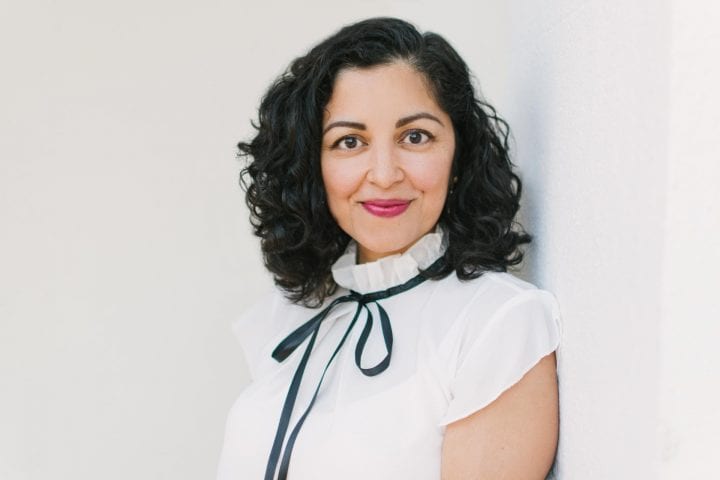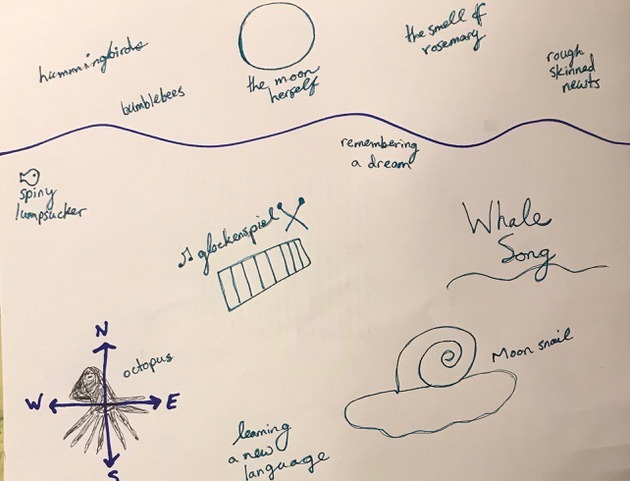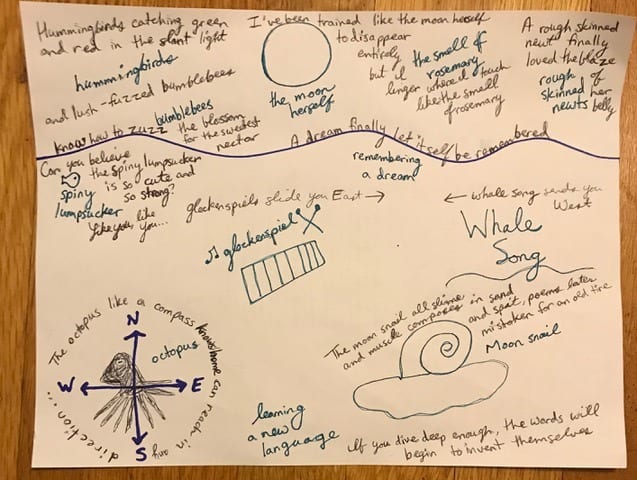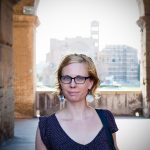
Accepting Aimee Nezhukumatathil’s Oceanic Invitation by Sierra Nelson
November 26, 2020
As a special Thanksgiving treat, make your own poem-map of wonder with this lesson and writing prompt inspired by poet and author of World of Wonders, Aimee Nezhukumatathil!
In celebration of our brand new SAL/on air podcast episode featuring Aimee’s May 2018 reading, Sierra Nelson—WITS Writer-in-Residence, cephalopod enthusiast, and author of The Lachrymose Report—takes us through the steps to finding our own world wonders.
Listen to Aimee’s reading, then dive into the wide sea of noticing with her poem, “Invitation,” and Sierra’s fun exercise.
Invitation by Aimee Nezhukumatathil
Come in, come in. The water’s fine! You can’t get lost
here. Even if you want to hide behind a clutch
of spiny oysters — I’ll find you. If you ever leave me
at night, by boat, you’ll see the arrangement
of red-gold sun stars in a sea of milk. And though
it’s tempting to visit them — stay. I’ve been trained
to gaze up all my life, no matter the rumble
on earth, but I learned it’s okay to glance down
into the sea. So many lessons bubble up if you know
where to look. Clouds of plankton churning
in open whale mouths might send you east
and chewy urchins will slide you west. Squid know
how to be rich when you have ten empty arms.
Can you believe there are humans who don’t value
the feel of a good bite and embrace at least once a day?
Underneath you, narwhals spin upside down
while their singular tooth needles you
like a compass pointed towards home. If you dive
deep enough where imperial volutes and hatchetfish
swim, you will find all the colors humans have not yet
named, and wide caves of black coral and clamshell.
A giant squid finally let itself be captured
in a photograph, and the paper nautilus ripple-flashes
scarlet and two kinds of violet when it silvers you near.
Who knows what will happen next? And if you still want
to look up, I hope you see the dark sky as oceanic —
boundless, limitless — like all the shades of blue in a glacier.
Listen how this planet spins with so much fin, wing, and fur.
Source: Poetry (January 2017), from Oceanic (Copper Canyon Press, 2018)
Accepting Aimee Nezhukumatathil’s Oceanic Invitation by Sierra Nelson
So much happens when we say “yes” to this invitation of a poem by Aimee Nezhukumatathil. At times, we may not be quite sure if we are looking up (star-ward) or down (sea-ward) — are the “red-gold sun stars in a sea of milk” brilliant sea stars in the frothy water beneath our boat, or are they twinkling star fires, distant suns, above us in the milky way? Each one reflects the other. At times while reading this poem our head may start to swim with the effervescent wave crash of images and sensory detail, one after the other.
But this teeming undersea of wonders also becomes its own kind of guide. If we were peering into this poem like a very deep tide pool — can you find 14 creatures hiding in there?* (Look closely! I’m also counting a shell as a sign of the creature within.)
Until the whole poem becomes a kind of map — with different creatures sending you “east” and others sliding you “west.” And which creature in this poem becomes a compass “pointed towards home”? (Hint: It has a “singular tooth”!)
PROMPT: Now try making your own poem-map of wonder!
Step 1: Brainstorm a quick list of at least 10 things that are wondrous (to you). They could all be from one category (for example, sea creatures), or any type of wonder.

Step 2: Next get a new piece of paper (or the back of your list) and sketch a visual map, placing all of your wondrous items somewhere on that map. Consider which of your wonder items should go to the “west,” and which go to the “east.” You might choose to draw a line across the page for a horizon, if some of your wonder items are “deeper” and some closer to the horizon surface or in the air. (Or maybe your map is from a bird’s eye view and more like a treasure map? It’s up to you!) Is there one wonder item that’s part of your map’s compass, pointing you toward home? Use your imagination and have fun with it. There is no wrong way to make your map!

Step 3: Now it’s time to add details and set your wonders in motion. You might choose to do this in written poem form, using your map for ideas. Nezhukumatathil’s “Invitation” encourages us to perceive with all of our human senses, and beyond (“If you dive / deep enough… / you will find all the colors humans have not yet / named.…) — so see what colors, motions, textures, mouth-feel, etc. you can weave in as you go.
OR, you can keep going on your drawn map, writing in more sensory details and lines of poetry right onto the map itself.
If you’re feeling a little stuck, try completing some or all of these sentence stems borrowed from Nezhukumatathil’s poem (or go your own way!):
Can you believe…
_____ know how to ______
I’ve been trained to __________, but I’ve learned it’s OK to…
A __________ finally let itself __________
If you dive deep enough…
________ send you east
________ slide you west
________ like a compass…
And if you still want ______, I hope…
Listen how…
*Answer to 14 creatures: spiny oysters, sun stars, plankton, whale (mouth), urchins, squid, humans, narwhal, imperial volutes, hatchetfish, black coral, clams (clamshells), giant squid, paper nautilus.

Sierra Nelson is a poet, president of Seattle’s Cephalopod Appreciation Society, and co-founder of literary performance art groups The Typing Explosion and Vis-à-Vis Society. Her poetry books includeThe Lachrymose Report (PoetryNW Editions, 2018), lyrical adventure I Take Back the Sponge Cake made with visual artist Loren Erdrich (Rose Metal Press), and the Vis-à-Vis Society collaboration 100 Rooms: A Bridge Motel Project (Entre Rios Books). Recently Nelson’s poems accompanying ichthyologist Adam Summer’s fish skeleton photographs were exhibited at the Ljubljana Natural History Museum and Piran Aquarium in Slovenia.